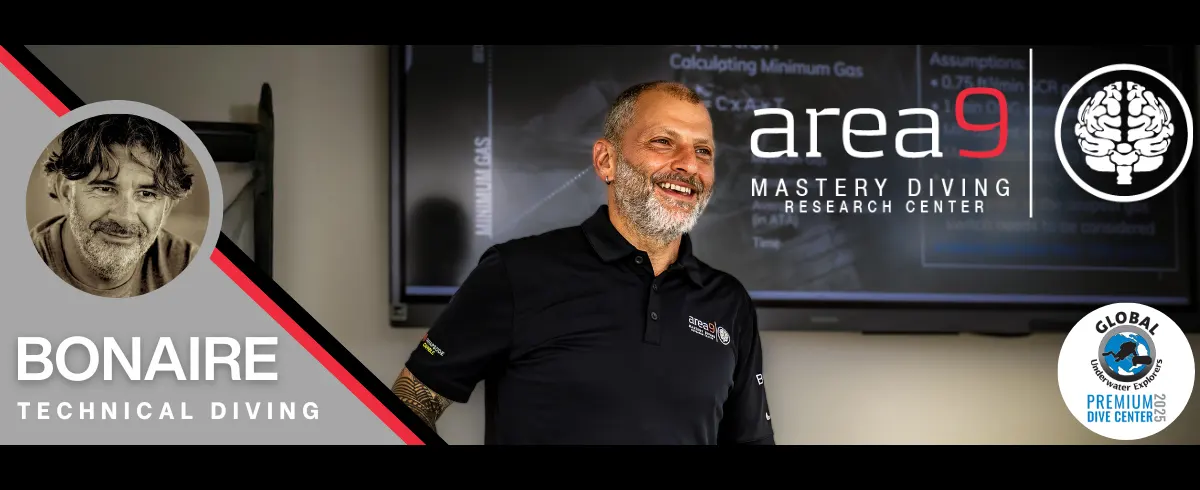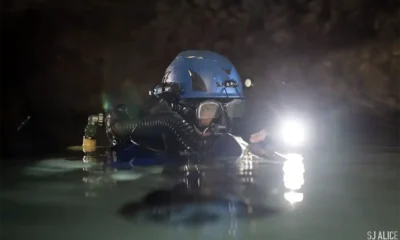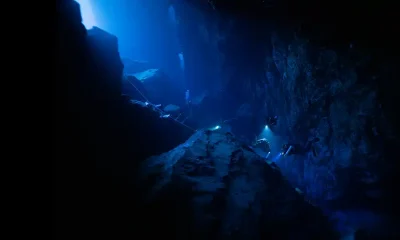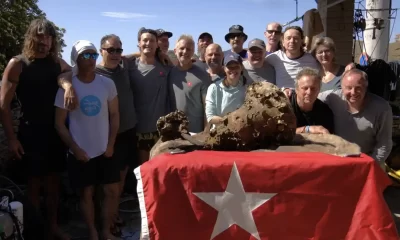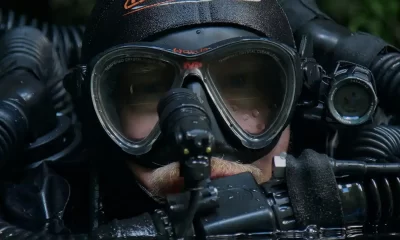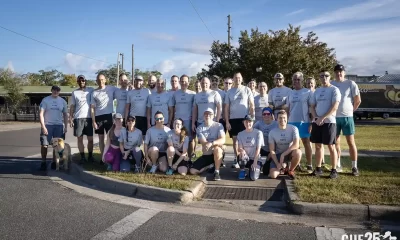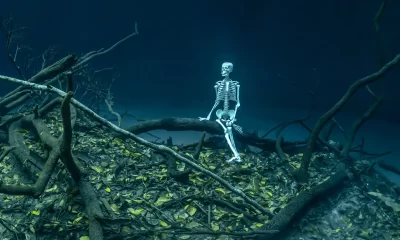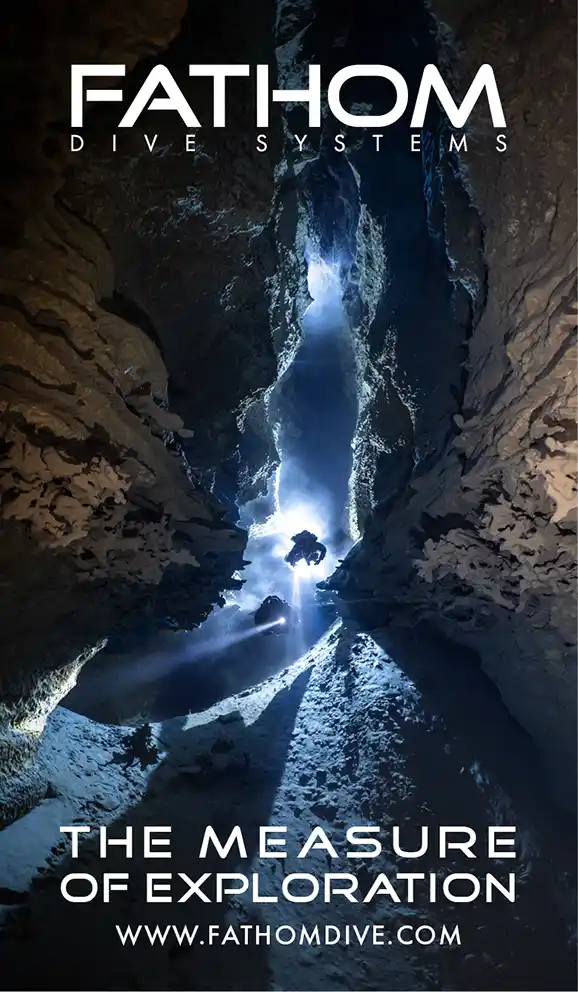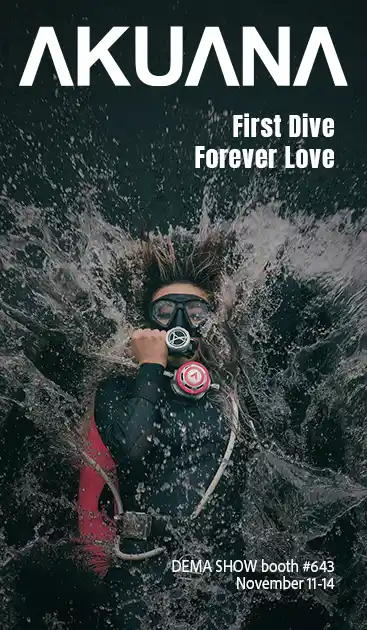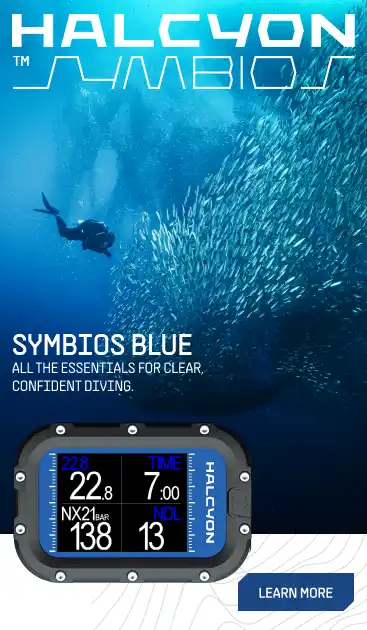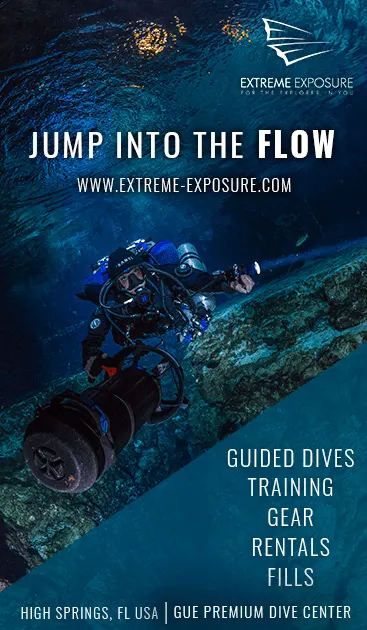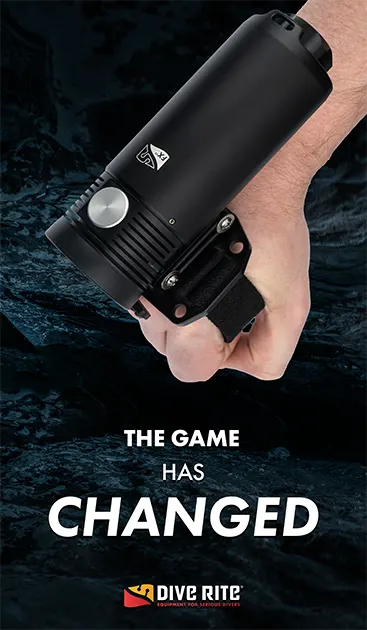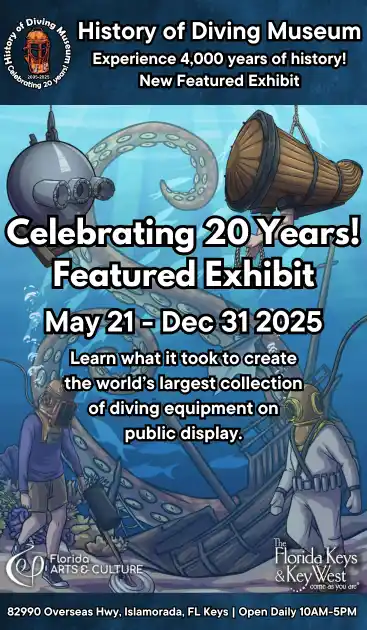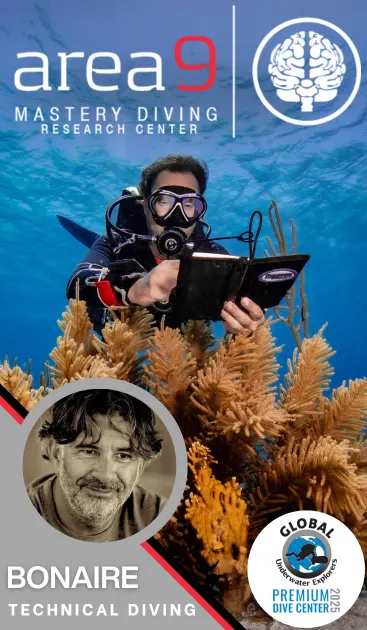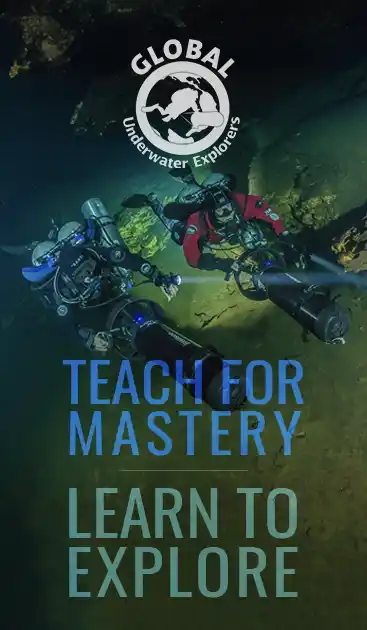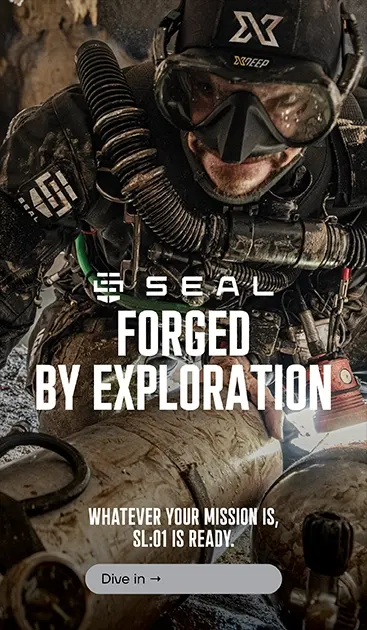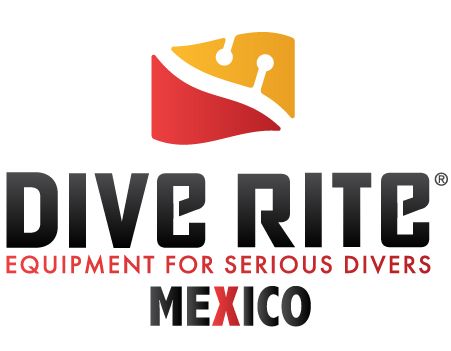Cave
Pioneers Remember Sheck

We invited some of our pioneers, the majority who were contemporaries of Sheck, to share their thoughts on the man, and how he influenced their diving and cave diving at large. Here is what they had to say.

Nuno Gomes
Cave explorer and deep diving record holder
An Honor to Dive with Sheck
I first met Sheck Exley, during his expedition to Bushmansgat cave, in South Africa, where I was invited to be part of the team. Sheck would attempt to beat two world records. The first would be the deepest cave dive, using trimix (7% O2, 65% He, 28% N2), when he would attempt to reach the bottom of the cave; the second record would be the deepest cave dive, using air. He was successful in both attempts.
During the approximately two-week-long expedition as his deep support diver, I would learn a lot from him while getting to do some great deep dives, as well.
From Sheck, I learned a lot about decompression/decompression techniques and gas blending. I also learned about equipment configuration, such as using two wings, even when using a dry suit. I learned how to set up stages in caves and how to properly prepare for a deep dive.
Sheck was a humble, unassuming man whose dives did the speaking for him. I was very fortunate to have met him and am thankful for the knowledge that he shared with me.

Larry Green
Cave Explorer and instructor
An Important Lesson
On March 12, 1994, two days before my 45th birthday, I met with George Irvine and Sheck Exley at Eagle’s Nest Sink in Hernando County, Florida, for a dive. The plan was to go downstream to the last chamber that Jim and I first discovered and explored in 1990. At this time, no leads had been found leading from this chamber. The permanent line entered through an upward rocky restriction and ran across the middle of a large room. The plan was that shortly after Sheck and I entered the room, we would tie into the permanent line, reel out in opposite directions, and look for any potential leads.
The visibility was good as I swam to the left following the wall. After 30-46m m/100-150 ft, the wall cut under, and the floor dropped—allowing approximately four feet of clearance—and the visibility improved. I dropped in to take a look but, unfortunately, nothing was found, and it was time to turn the dive. Arriving back at permanent line, I could see that Sheck wasn’t reeling up his line but was surveying it with George following providing light. With reels tucked away and a high five, we headed home.
On the surface Sheck said that he found a duck under similar to what I had found, but this led to another small room, a rocky bottom about 15 m/50 ft across. Sheck said that he reached what appeared to be the back wall, visibility got bad, so he tied off his line on a rock and surveyed out. We used DR X tables; our bottom mix was trimix 14/32 and our deco gases were nitrox 37%, nitrox 52% and oxygen. Staying close to the ceiling, our max depth was only 88 m/290 ft, and total bottom time for the dive was 277 min.
My curiosity got the best of me, so I contacted Randy McGuire to dive with me to go take a look at the end of Sheck’s line. Two months later, on May 7, Randy and I met up at the Eagle’s Nest for our dive. We got to the last large room downstream, and took the first T to the right, which was Sheck’s last line laid in Eagles Nest. After only 30 m/100 ft or so, the line dropped through a rocky restriction. I indicated for Randy to hold at the restriction and that I was going to take a look.
The bottom was breakdown and I moved through the restriction into room with a slightly domed ceiling. The visibility was great. I continued to follow the line across the room to find the line terminating on a rock. The line was tied to this rock, with an exit marker, that had me looking at another rocky restriction dropping into another chamber.
This is where I learned a very important lesson. Whenever you think nothing can go wrong, you’re about to get in trouble. At this point, I was five restrictions and nearly 915m/3,000 ft from open water at a depth of 88m/290 ft. The visibility was the clearest I’ve ever seen, and the bottom was rock, so what’s the problem with dropping through the restriction just to take a look around, without tying in? Almost immediately after clearing the restriction, I discovered and disturbed my first halocline in Florida!
Yes, I eventually found my way out. Be smart, and remember, without fear there is no courage! Stay Safe!

Jill Heinerth
FRCGS, D. Lit. h.c., Explorer in Residence, Royal Canadian Geographical Society
A Lesson from Atlantida Tunnel
In 2008, I had the chance to dive the Atlantida Tunnel in the Canary Islands—the longest submerged lava tube in the world. Twenty-five years earlier, Sheck Exley had nearly lost his life there, and standing in that same space, I felt the weight of history, human fragility, and resilience. His story cemented a truth: survival doesn’t have to be tidy, just effective.
In 1983, Exley and his partner, Ken Fulghum, attempted a record-breaking dive over 4,500 feet deep inside the tunnels of the Monte Corona Volcano. At 180 feet, buzzed from nitrogen narcosis, they suffered a catastrophic gear failure. Unaware of losing gas, Fulghum swam back to Exley, who shared his air. But soon, both were nearly empty. They sprinted toward their stage tanks, gasping for air, but ran out again. Struggling through carbon dioxide buildup and dizziness, they made one final breathless push to their last tanks, snagging the guideline multiple times but keeping their composure.
They realized they’d run out of gas once more at their decompression stop, so Fulghum, who was responsible for the incident, surfaced to call for help. Luckily, Tom Iliffe was waiting above and tossed double tanks into the water, where they tumbled down to 70 feet, saving their lives. Against all odds, both divers made it home safely.
As I explored that cave decades later, searching for unique biology with Tom Iliffe, the gravity of Exley and Fulghum’s survival felt even more astonishing. Their story was a reminder: every dive carries the weight of what we might leave behind. The key to survival is patience, respect for the plan, and never giving up.

Paul Heinerth
Cave explorer, instructor and dive center owner
Exley: A Force of Nature
From early on (since we met,) I knew he was a force in cave diving. He was instrumental in the creation of the NACD in 1968 and then the Cave Diving Section of the NSS around 1973-1974.
He was always busy teaching cave diving and exploring the many caves we have in north Florida, the Bahamas, and northern Mexico. He had a mind for numbers. We led a joint Explorers Club Expedition to dive, explore, and map Giant Cave in Belize back in 1982. He also had a goofy side, always hamming up the tasks at hand like knotting lines or loading up the empty reels.
He had a ferocious appetite. Lobster omelette for breakfast, lobster burger for lunch and two lobster dinners at the end of each day!
After a week of diving, we had over 8,000 feet of surveyed cave and the cave gave no signs of ending. On the last day there he stopped me as we walked back to the Belize Diving Service dive shop and said:” Do you realize we just did a record dive?
“How so” I asked? (I had been diving there for four winter seasons).
He said, “This is the longest salt water cave in the world with only one entrance.” Then he mentioned all the other salt water caves with their stats of depths, distances and number of openings, He was right. He possessed an impressive amount of data in his head about records. 🙂

Lamar Hires
Cave explorer and founder of Dive Rite
Learning from Sheck
On the personal side with Sheck, I remember the early days at Dive Rite before we moved to town in 1992. Sheck came to visit us several times at the original Dive Rite off King Rd in Lake City [Florida] while doing his Mexico Mante Dives. We did maintenance on his gear, and I would load his old 4400 enclosed reel with knotted line. He told me the knotted line was the one way to measure and confirm his depth on the descents.
I used our line counter and knotted it every 10 ft. He had emptied a 400-ft spool and, without saying how deep he had been, he asked me to load it up again. I remember asking, “Do you want the knots every 15 ft like last time?” He froze in his tracks. I got a laugh from that and then said, “Ten foot knots as usual.”
On one of the later visits, Bill Dooley joined us to bore out his Poseidon regulator for the deeper dives. On that visit, he asked me to blank off the OPV on his Dive Rite wing. I told him it was not a good idea to do that, since it needed to be able to vent gas. I will never forget Sheck’s next words. He asked me if I knew how much gas it took to fill the 60-pound wing at 700 ft. I looked at him with a “Hell if I know” look, and he told me it would take an aluminum 80 to fill it, so I didn’t want to waste any gas through the OPV. I said, “No shit,” and plugged it. That visit was a wake-up call for me to what deep diving really was.

Jarrod Jablonski
Explorer, founder and president of Global Underwater Explorers (GUE)
Exley: An unassuming Man
Sheck’s profound impact upon technical and cave diving extends well beyond his incredibly impressive diving accomplishments. I had read about Sheck’s many accomplishments ever since I first got into technical diving, but the more I got to know him, the more impressed I became. Sheck managed to merge an unassuming and warm personality with a tenacious perseverance to push beyond all known boundaries.
One of my favorite memories of Sheck sprung from my first dive with him. Sheck had begun diving with our WKPP team, but he was new to the team. True to Sheck’s generous personality, he did not ask for any special privilege. He emphasized he was happy to offer his support and get to know everyone, lending assistance wherever possible. Given all that Sheck had accomplished, I was impressed he was happy to carry tanks and become a support diver.
After some time with our team, Lamar English became sick before a planned dive in Wakulla Springs. Sheck had joined the event with no plans to do more than support, but we asked if he was comfortable with an unplanned dive into Wakulla. He smiled and said it would be a privilege. We fully expected to provide some additional supplies, but Sheck went rummaging in his van and came out with nearly everything required for the three-stage dive into Wakulla. Off I went into Wakulla with Bill Main, Sheck Exley, and George Irvine.
This dive wasn’t anything remarkable in the list of exploration dives for any of us, but it remains one of my fondest cave diving memories.The day closed with Sheck offering each of us treats from his underwater food bag during deco and warm cider upon surfacing, where we all enjoyed a beautiful sunset in the background. I would have other chances to spend time with Sheck, and to celebrate his many accomplishments. It was a privilege to witness both his kindness and diving prowess—two things that made him a truly remarkable person.

Woody Jasper
Cave explorer
The D-Word
I asked Sheck what he was doing for deco tables for his deep dives. This is his exact quote delivered with a straight face, “a modification of an extrapolation of experimental tables from Bill Hamilton.”
He Left A Void
I met a former student of Sheck’s, who was a public school teacher in Live Oak, FL. He said that Sheck was the best teacher that he ever had. Sheck was also a “man of letters” as an author, note taker and keeper of writings. He was also America’s original and best known cave diver.
I meet Sheck and Mary Ellen in early 1980, as I had enrolled in their cavern course along with about 20 other want-to-bees. The owner of Branford Dive Shop had way overbooked the course, motivated by the $25 fee and potential gear sales. Sheck & Mary Ellen were surprised and chagrined at the numbers, but they still succeeded in providing a great experience with over 20 training hours in that busy two days. I, of course, continued with my cave training and my friendship with Sheck.
Sheck was very animated underwater, moving quickly and precisely, and forever racing the decompression clock. With his little red Tekna scooter, he seemed like a bumble bee looking around, tying off a reel, taking notes. We dove a spring that I had found south of Tallahassee. It was 58m/190 ft deep with a ripping flow. My line had been severed by the flow, so Sheck whipped out his reel, tied in and 30 feet (9m) later came to the other end of the line where he did a proper repair and stowed his reel. Eighty feet (24m) further there was another break in the line, so he repeated the process, taking us to the end of my original line, where we finally begin exploring. It’s not too exciting in the retelling, but Sheck’s speed and efficiency was truly something to see. I believe he logged this as his 3000th dive. Friendly, approachably and very genuine, Sheck left a void in cave diving that will never quite be filled.

Brian Kakuk
Cave explorer and instructor
A Driving Force
A highly respected cave diver in early 1990’s, unassuming Florida algebra teacher, Sheck Exley was a driving force in what was then, the newly coined term “Technical Diving.” His exploits and dedication to protocol and training led the way for rising explorers. He made available gas alternatives that were previously reserved for military and commercial divers. His DEEP Inc. training, as well as his authoring the first commercially available decompression software program, gave rising explorers like myself the ability to plan safe, deep, mixed gas dives and get us off the destructive path of deep air exploration. For that Sheck, I will always be grateful to you.

Ann Kristovich and Jim Bowden
Cave explorers
An Extraordinary Man
Sheck Exley was more than a pioneer in the world of cave diving—he was an explorer whose courage and intellect pushed the boundaries of what was thought possible beneath the earth’s surface. His meticulous approach combined with an insatiable drive to go deeper and further, set the standard for technical divers worldwide. From the submerged labyrinths of Florida’s springs to the daunting depths of Mexico’s cenotes, especially Nacimiento Mante and Zacaton, Exley approached each dive with a unique blend of scientific precision and unwavering passion. His contributions to decompression theory and deep cave exploration paved the way for future generations and ensured that his legacy would live on in the safety protocols and techniques still in use today.
Beyond his unparalleled skill and daring spirit, Sheck Exley was a mentor, a teacher, and a friend. His humility and generosity left an indelible mark on the diving community, inspiring countless others to follow in his footsteps while respecting the risks inherent in extreme exploration. Though his life was tragically cut short in pursuit of his dream of reaching 1000 feet of depth, his impact on the field remains immeasurable. Those of us who had the privilege of knowing him remember not just his extraordinary feats but also his wry humor, quiet wisdom, and dedication to sharing knowledge. Sheck Exley was more than a legend—he was a testament to the power of human curiosity and determination.
Here is the story of Sheck, Jim and Ann exploring Zacatón from aquaCORPS #11 Underground XPLORERS (AUG95): Dr. Ann and the Zacatón Explorers by Jim Kelly

Bill Hogarth Main
Cave explorer, co-founder of the Woodville Karst Plain Project (WKPP)
Exley: The Man with the Answers
My first dive with Sheck Exley was on August 25, 1979, in Jade Hole (Falmouth system). Most, if not all, of my dives with Sheck were exploration dives at that time, and all cave divers were breathing from their short hoses and donating their long hoses. It was Sheck who introduced breathing from AND donating the long hose, and I transitioned to doing so, too, when Sheck explained his rationale. His pamphlet Basic Cave Diving: A Blueprint for Survival certainly prevented accidents.
Sheck’s surveys of cave systems were extremely accurate. And any time I had a question about cave diving history, Sheck always had the answer. His wealth of knowledge in this regard is something I still miss 30 years later.
Back in the late 70s or early 80s, we used to have decompression “wars.” The most extreme was in Catfish Hotel with Sheck, John Zumrick, Mary Ellen Eckhoff, and me. John Zumrick came up behind Sheck with a small log, hooked it between Sheck’s manifold and tanks and pushed Sheck around the sink.

Dr. Drew Richardson
President and CEO, PADI Worldwide
Exley: Mentor and Hero
Sheck Exley was both a mentor and hero of mine. His book, Basic Cave Diving: A blueprint for Survival, had a profound impact on my diving practice and my career in diver training and diving educational curriculum and standards development. I poured over it in North Florida cave country when it first came out in 1979. In those days, I was a certified NACD and NSS-CDS diver. I had a Ford panel van that I customized and converted into a diving safari camper and frequented the springs and cave systems of Florida- often camping spring side to the systems he described in his book.
His accident accounts and incident analysis really stuck with me in my own personal dive safety practice and in teaching others in my diving instructor practice. We had friends and colleagues in common in the diving and cave community, some were my mentors who also knew Sheck well. As a young guy, I met Sheck many times and had the opportunity to dive with him in Madison Blue in the late 1970s. He was always humble and respectful and took the time to say hello and have a quick chat even though he was at such a more advanced and elite level.
Later when I was working at PADI developing our educational and training system, and also as President of Diving Science and Technology, I was honored to sit on a dive safety panel with others including Sheck at an early Tek.Conference. Truly a diving icon, Sheck’s work, experience, safety practices and humility were revelatory to me and were a profound influence on my career.

Robbie Schmitter
Cave explorer and former dive center owner
Exley: Every Diver’s Mentor
Unfortunately, I never had the opportunity to meet Sheck Exley in person, as he passed away two years before I began my cave diving training. However, his presence was felt from the very first day of my course. My study materials included, among others, his books Blueprint for Survival and Caverns Measureless to Man. Exley fundamentally shaped cave diving training and implemented many of the “Golden Rules,“ such as the gas consumption regulation (thirds rule).
In my career as a cave diver, I had the privilege of meeting many icons of cave diving, such as Wes Skiles, Jim Coke, Dan Lins, Lamar Hires, Bill Phillips, Paul Heinerth, and Brian Kakuk – just to name a few. However, whenever the conversation turned to Exley, the respect in the voices of all these people was unmistakable.What impresses and inspires me most about Exley was his true spirit of exploration. He did what an explorer must do to reach “new territories“: He pushed himself, reimagined conventional configurations and methods, and continually reinvented himself and his practices to get to places where no human had been before.

Court Smith
Cave explorer
Remembering Sheck Exley
My first dive with Sheck was in Zuber Sink in July 1972. Lewis Holtzendorff, Sheck, and I had a 15 minute bottom time to 240 ft deep breathing compressed air. Both Lewis and I experienced vertigo while Sheck had no issues. We had similar experiences diving in Eagles Nest. Sheck had a remarkable ability to successfully deep dive on air.
I remember diving historic White Springs in April 1972. It was our first exploration of a virgin spring. Lewis and I told Sheck about it and he was excited to go see it. After around 20 dives at other locations, we hooked up with Sheck and Dana Turner to continue exploring White Springs. We added 300 feet of line to a depth of 155 feet in the darkest, nastiest tunnel you can imagine. Sheck loved it. To him, exploration was most important. We were all on board with that!
In late September 1973, Sheck and I had one of the greatest Florida springs exploration weekends I have ever experienced. We explored 800 feet of new passage in Blue Springs, Washington County, Florida (a great dive). We also stopped off and explored 100 ft of new passage in Williford Springs (a terrible dive). Then, we headed to Blue Springs in Jackson County and swam to the end of the explored passage—I think we explored a little further (a fantastic dive). Finally, Sheck had heard of a new discovery in Little Dismal sink. We stopped by on the way home, went through a horrific restriction, promptly found the end of the line at 110-feet deep and explored an additional 400 feet of huge passage in air-clear water to a depth of over 200 feet—an unbelievable discovery!
Sheck was an extraordinary man. He had a good, healthy laugh and a great sense of humor. He stood by my side in times of crisis. He would do anything to help a friend. He was a terrible maintainer of diving equipment. But, most of all, he was TERRIFIED of snakes. I once chased him down the banks of the Santa Fe River with a harmless rat snake in my hand. I couldn’t catch him. He was a better athlete. And that’s only the beginning.

Edd Sorenson
Cave explorer, instructor, dive center owner
A Tribute To The Legacy Of Sheck Exley
Sheck Exley’s profound influence on cave diving cannot be overstated. Even before I began my formal cave training, the stories surrounding his achievements ignited my fascination with the sport. While I never had the privilege of meeting him—my early diving years were spent on the West Coast, far from his Florida roots—his work and reputation reached me through every corner of the diving world.
A foundational element of my training involved reading Blueprint for Survival, which I still regard as one of the most pivotal texts for cave divers. Within those pages, Sheck underscores a key principle: cave diving leaves no room for error. He emphasized learning from the mistakes of those who came before us, and he dedicated himself to revising and refining the rules that define safe cave diving practices.
Embodying this philosophy, I decided to become an instructor with the specific goal of helping others. My father’s guiding principle—“Help your fellow man whenever possible”—shaped my decision to join the International Underwater Cave Rescue and Recovery (IUCRR) team as a recovery diver. Many cautioned against it, arguing it was too dangerous and unpaid. Yet I saw it as an opportunity to serve others and potentially prevent further tragedies.
That responsibility drew me into body recoveries early in my career, each one a stark reminder of the gravity of cave diving. Every recovery reinforced my commitment to becoming a skilled instructor—if I could train divers thoroughly and instill in them the respect for the risks involved, fewer tragedies would occur. It was Sheck’s core message, internalized from his writing and from his pioneering work, that pushed me to elevate my teaching standards and practices.
Sheck Exley’s role in advancing cave exploration also shaped my perspective on the sport’s potential. He ventured farther and deeper than any diver of his time, demonstrating both the limitless possibilities and the inherent dangers of the pursuit. Though his drive eventually cost him his life, he left behind an invaluable legacy of safety standards and procedures. He was both a rule-follower and a rule-maker, dedicated to informing and protecting those who would follow in his footsteps.
Blueprint for Survival remains on my list of must-read materials for cave diving students. In my opinion, modern divers risk overlooking its lessons amid the distractions of social media, which sometimes promotes “feel-good” instructors who focus more on pictures and prestige than skill-building. While there is beauty to be shared in underwater photography, our first duty as instructors is ensuring diver competence and safety rather than curating the perfect image.
In my role as an instructor, and as the NSS-CDS Safety Director, I travel worldwide to share the fundamental truth Sheck advocated: cave diving is safe when approached with proper training and a profound respect for potential dangers. Conversely, it is utterly unforgiving of complacency and unpreparedness. Upholding this principle is the best way to honor Sheck Exley’s memory. By passing down his insistence on rigorous safety, clear-headed judgment, and careful exploration, we extend his legacy, keep divers alive, and enable the spirit of discovery he championed to thrive.

Richard Taylor
Instructor and founder of OZTek Advanced Diving Conference
An Immeasurable Legacy
In the tech diving world, many names are cast around as “pioneers,” but few could ever exemplify this more than Sheck Exley.
In the early 90’s in Australia, the world of “tech” was just starting. Decompression, mixed gas, even Nitrox were “voodoo,” and many in the industry wanted little to do with it (pretty much like most of the diving world at the time).
Knowledge was gleaned from “CompuServe” forums, reading actual books, and being part of a slowly growing underground.
Even then, Sheck’s name was known—and admired. Being a member of the CDAA and going cave diving gave me access to Sheck’s Blueprint for Survival. It was simply…inciteful! Not just for cave diving, but the principles were directly transferable to tech diving, and especially the deep wreck air dives (250ft+) we were doing.
And then came DrX! Sending faxes to Sheck to get a version on a “floppy” disk, loading it in DOS and getting actual customised tables.
It was brilliant! He opened up the whole idea of customisable decompression tables. And by “customised,” this included back and forth tweaks to the code when there was a slight “niggle” or a little down time needed on extra oxygen after the dive.
He was a real gentleman. And he loved to talk decompression theory, cave exploration, and all things diving.
I met him when he came to Australia courtesy of Tony Davis (AquaTech, Dive-Rite & the CDAA), and his stories and personality were as he was— legendary.
They say a person is best remembered by the quality of the people who admired them. Sheck was admired by pretty much everyone, even some of the more “extreme” internet posters of the day. His dive buddies were themselves legends.
It is also said that those who walk the frontier can expect to be shot at with arrows. Sheck was no different. His passing was a shock, but his legacy was immeasurable.
But, thank you Sheck, for giving me the opportunity to be part of the rollercoaster start of the tech diving adventure…and to still be here to talk about it!

Michael Thomas
TDI cave Instructor, CDG National Training Officer
Exley’s World-wide Influence
After being an open water diver since 1987, my technical diving career began around 1992. Sheck Exley was one of the few names from the USA that was well known in the UK cave scene at the time, and I searched for any information on his long and deep cave dives. I had been fascinated and eager to learn what was involved to conduct these dives of his. Sadly, in late April or early May, 1994, I heard of his passing while in one of the caving cafes in the village of Ingleton, in the Yorkshire dales, where many cave divers gathered. In this caving hotspot, discussions on what, why, and how continued for a long time. Even all the way in the UK, Sheck had an impact on the larger diving community by showing us what was possible on long and/or deep diving. What stands out for me the most, still, was the mindset needed to risk, to push, and to explore the inner space.

Patrick Widmann
Cave explorer, instructor and dive center owner
Exley’s Legacy
Sheck Exley’s spirit is present in almost every exploration dive I make. His relentless pursuit of the unknown resonates so deeply within me! Reading his “Basic Cave Diving: A Blueprint for Survival” kick-started my curiosity for cave diving. Then I devoured “Caverns Measureless to Man,” which was just crazy epic with insane stories about exploration and boldly going where no one has gone before. After reading it, exploring the unknown became an obsession. Exley’s dedication to physical fitness as a crucial element of safe exploration also inspires my commitment to peak condition—knowing that extreme remote expeditions demand both mental and physical fortitude. “Dive your own dive” isn’t only a powerful quote; it’s also the foundation of my approach, demanding constant self-assessment and unwavering adherence to my limits.
My connection to Exley feels almost tangible, due to my direct Instructor family tree tracing back to him: Sheck trained Wes Skiles to be an Instructor, who then did the same for Lamar Hires. Lamar then certified Dan Lins, who then guided Andreas W. Matthes to be an Instructor, who ultimately mentored me to be a technical cave diving Instructor in 2007. This lineage is a profound honor, a reminder of the responsibility I bear to uphold Exley’s legacy of teaching safe cave diving, pushing boundaries, respecting the environment, and always, always, diving my own dive.
His final dive serves as an ever-present reminder that even the best can perish in the pursuit of exploration. It’s a stark lesson in humility and the unforgiving nature of cave systems. As T.S. Eliot wrote, “Only those who will risk going too far can possibly find out how far one can go.”
Return to the Sheck story package, “Revisiting the Legacy of Sheck Exley.“

